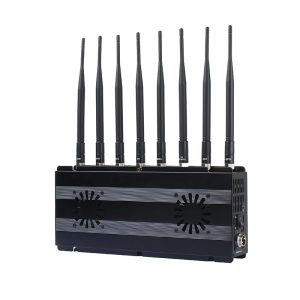Jammers in libraries: Balancing quiet and digital needs
In today's digital age, libraries, as traditional temples of knowledge, are facing unprecedented challenges. The popularity of smartphones, tablets, and other electronic devices threatens the core value of libraries, "quiet reading". To address this problem, more and more libraries are considering or have deployed cell phone signal jammers and Wi-Fi jammers. This article will explore the pros and cons, legal considerations, and possible alternatives to this technology application.
https://www.thejammerblocker.com/
Why do libraries need jammers?
Walk into any modern library and you will likely see someone concentrating on studying ancient books, while another reader is making a loud video call a few steps away. This contradiction is the main reason that drives libraries to consider jammer technology.
Noise pollution has become one of the biggest challenges facing modern libraries. Studies have shown that constant cell phone ringing and conversations can significantly reduce the attention and reading efficiency of other readers. According to a 2022 survey by the American Library Association, 78% of respondents said they had been disturbed by other readers' cell phone use.
In addition, over-reliance on digital devices also affects the core mission of libraries. Many readers spend most of their time on social media or video sites when they come to the library, rather than taking advantage of the library's rich physical resources. Supporters of jammers believe that these devices can help readers "digitally detox" and refocus on deep reading.
https://www.thejammerblocker.com/cell-phone-jammer-blocker-for-gsm-5g/
How jammer technology works
The jamming systems used in modern libraries are far more complex than simple signal blocking. These systems typically include the following components:
[list]
[*]
Selective frequency jamming module: can accurately block specific services (such as voice calls, social media applications) while retaining emergency communication channels
[*]
Geofencing technology: ensures that the jamming effect is limited to specific areas within the library (such as quiet reading areas)
[*]
Smart scheduling system: allows for enhanced jamming intensity during specific time periods (such as during exams)
[/list]
It is worth noting that the most advanced systems have been able to achieve application-level jamming. For example, only games and video streaming applications are blocked, while retaining access to academic databases and e-book platforms.
Global case studies
https://www.thejammerblocker.com/wifi-bluetooth-camera-jammer-blocker/
Despite the controversy, some libraries have tried different forms of interference solutions:
[list=1]
[*]
Tokyo Metropolitan Library, Japan: Installing a "focus mode" system in specific reading rooms, readers can voluntarily turn on the device blocking function
[*]
Berlin State Library, Germany: Using acoustic interference technology (white noise generation) instead of electronic interference to create a quiet environment
[*]
Boston Public Library, USA: Piloting a "digital fasting zone" that uses low-power interference to block only social media applications
[/list]
These cases show that solutions can be more sophisticated and humane than simple full-band blocking.
Alternatives Exploration
https://www.thejammerblocker.com/audio-recorder-jammers/
Given the legal and technical risks, many libraries are choosing to adopt non-interference solutions to digital interference:
[list]
[*]
Architectural design solutions: Setting up dedicated "silent cabins" and anti-electromagnetic shielding reading rooms
[*]
Behavior guidance strategies: Cultivating digital etiquette through sign systems, reader education and staff guidance
[*]
Technology neutral zones: Providing traditional reading areas without power outlets and Wi-Fi
[*]
Voluntary shielding bags: Providing readers with mobile phone storage bags made of Faraday cage materials
[/list]
Although these methods may not be as effective as jammers, they avoid legal risks and are more in line with the open spirit of libraries.

Future Outlook
As technology develops, we may see smarter and more legal "interference" solutions emerge. AI-driven acoustic management systems can identify and offset noise sources in real time, while adaptive Wi-Fi policies can automatically adjust network permissions based on area and time.
Blockchain technology may also play a role, allowing readers to manage their digital behavior through decentralized reputation systems. Readers who perform well can get faster network speeds or longer device usage time.
Conclusion: Finding a balance
https://www.thejammerblocker.com/uhf-vhf-lojack-rf-jammer/
The debate over library distractors is essentially about how to redefine the norms of public space use in the digital age. Ideally, the solution should balance:
[list=1]
[*]
Respecting personal digital freedom and maintaining public space order
[*]
Protecting traditional reading values and embracing technological innovation
[*]
Ensuring secure communications and creating a distraction-free environment

[/list]
Perhaps the answer is not whether to use distraction technology, but how to develop a smarter system that respects user choice. As a social knowledge infrastructure, libraries have a responsibility to lead this conversation about the attention economy, rather than simply prohibiting or allowing it.
Ultimately, a truly intelligent library should be able to quietly guide readers to find the perfect balance between technology and tranquility, just like a skilled librarian.
https://www.thejammerblocker.com/t-us-z14-2g-3g-mobile-internet-communications-jammer-3-antennas-30-meters/
https://www.thejammerblocker.com/
Why do libraries need jammers?
Walk into any modern library and you will likely see someone concentrating on studying ancient books, while another reader is making a loud video call a few steps away. This contradiction is the main reason that drives libraries to consider jammer technology.
Noise pollution has become one of the biggest challenges facing modern libraries. Studies have shown that constant cell phone ringing and conversations can significantly reduce the attention and reading efficiency of other readers. According to a 2022 survey by the American Library Association, 78% of respondents said they had been disturbed by other readers' cell phone use.
In addition, over-reliance on digital devices also affects the core mission of libraries. Many readers spend most of their time on social media or video sites when they come to the library, rather than taking advantage of the library's rich physical resources. Supporters of jammers believe that these devices can help readers "digitally detox" and refocus on deep reading.
https://www.thejammerblocker.com/cell-phone-jammer-blocker-for-gsm-5g/
How jammer technology works
The jamming systems used in modern libraries are far more complex than simple signal blocking. These systems typically include the following components:
[list]
[*]
Selective frequency jamming module: can accurately block specific services (such as voice calls, social media applications) while retaining emergency communication channels
[*]
Geofencing technology: ensures that the jamming effect is limited to specific areas within the library (such as quiet reading areas)
[*]
Smart scheduling system: allows for enhanced jamming intensity during specific time periods (such as during exams)
[/list]
It is worth noting that the most advanced systems have been able to achieve application-level jamming. For example, only games and video streaming applications are blocked, while retaining access to academic databases and e-book platforms.
Global case studies
https://www.thejammerblocker.com/wifi-bluetooth-camera-jammer-blocker/
Despite the controversy, some libraries have tried different forms of interference solutions:
[list=1]
[*]
Tokyo Metropolitan Library, Japan: Installing a "focus mode" system in specific reading rooms, readers can voluntarily turn on the device blocking function
[*]
Berlin State Library, Germany: Using acoustic interference technology (white noise generation) instead of electronic interference to create a quiet environment
[*]
Boston Public Library, USA: Piloting a "digital fasting zone" that uses low-power interference to block only social media applications
[/list]
These cases show that solutions can be more sophisticated and humane than simple full-band blocking.
Alternatives Exploration
https://www.thejammerblocker.com/audio-recorder-jammers/
Given the legal and technical risks, many libraries are choosing to adopt non-interference solutions to digital interference:
[list]
[*]
Architectural design solutions: Setting up dedicated "silent cabins" and anti-electromagnetic shielding reading rooms
[*]
Behavior guidance strategies: Cultivating digital etiquette through sign systems, reader education and staff guidance
[*]
Technology neutral zones: Providing traditional reading areas without power outlets and Wi-Fi
[*]
Voluntary shielding bags: Providing readers with mobile phone storage bags made of Faraday cage materials
[/list]
Although these methods may not be as effective as jammers, they avoid legal risks and are more in line with the open spirit of libraries.

Future Outlook
As technology develops, we may see smarter and more legal "interference" solutions emerge. AI-driven acoustic management systems can identify and offset noise sources in real time, while adaptive Wi-Fi policies can automatically adjust network permissions based on area and time.
Blockchain technology may also play a role, allowing readers to manage their digital behavior through decentralized reputation systems. Readers who perform well can get faster network speeds or longer device usage time.
Conclusion: Finding a balance
https://www.thejammerblocker.com/uhf-vhf-lojack-rf-jammer/
The debate over library distractors is essentially about how to redefine the norms of public space use in the digital age. Ideally, the solution should balance:
[list=1]
[*]
Respecting personal digital freedom and maintaining public space order
[*]
Protecting traditional reading values and embracing technological innovation
[*]
Ensuring secure communications and creating a distraction-free environment

[/list]
Perhaps the answer is not whether to use distraction technology, but how to develop a smarter system that respects user choice. As a social knowledge infrastructure, libraries have a responsibility to lead this conversation about the attention economy, rather than simply prohibiting or allowing it.
Ultimately, a truly intelligent library should be able to quietly guide readers to find the perfect balance between technology and tranquility, just like a skilled librarian.
https://www.thejammerblocker.com/t-us-z14-2g-3g-mobile-internet-communications-jammer-3-antennas-30-meters/



